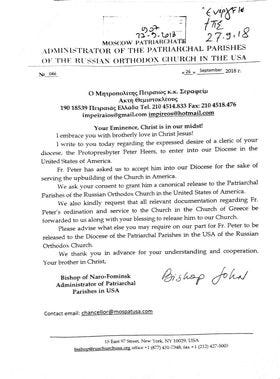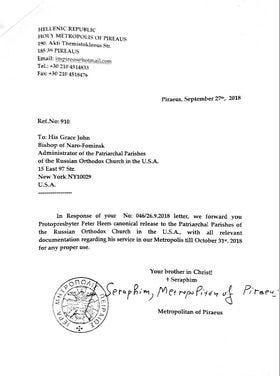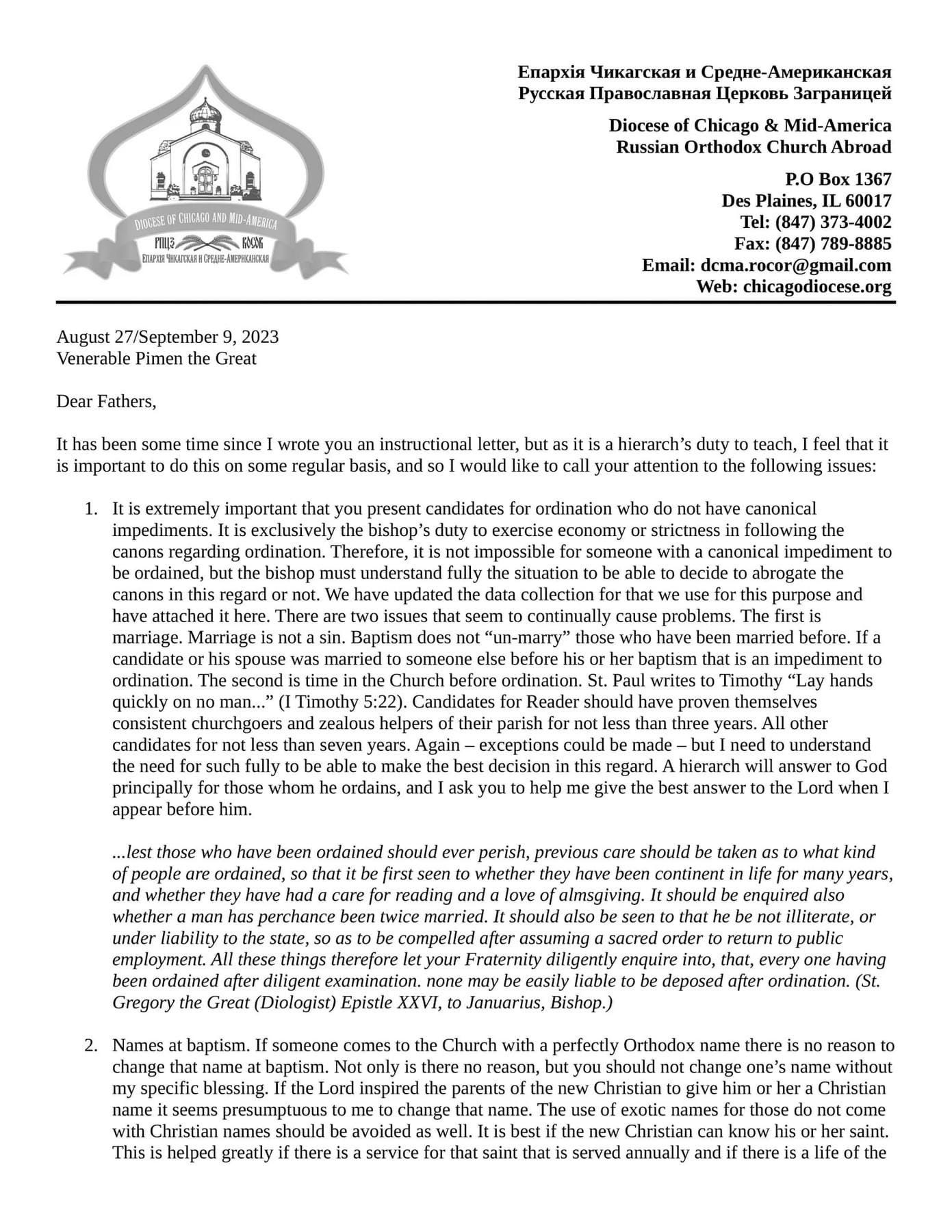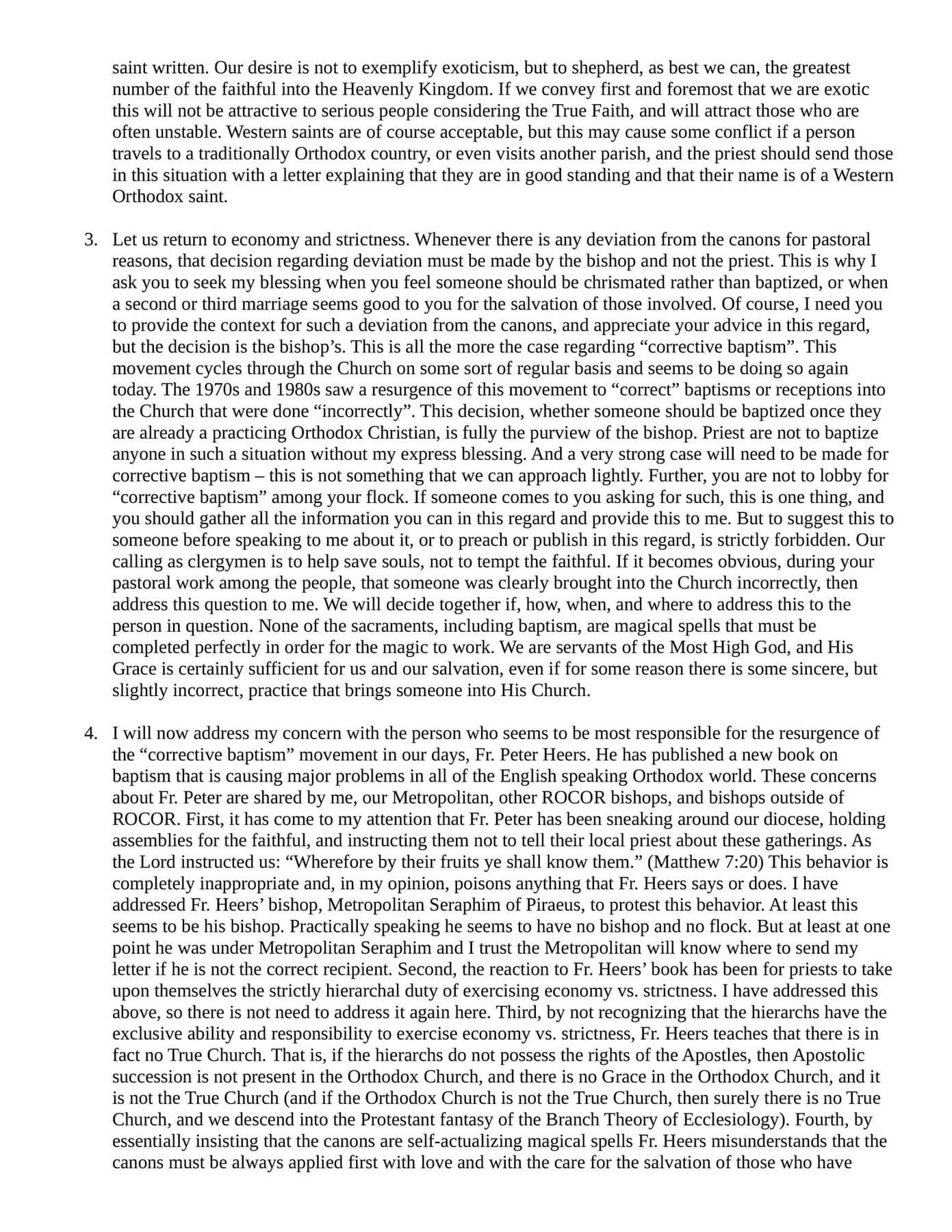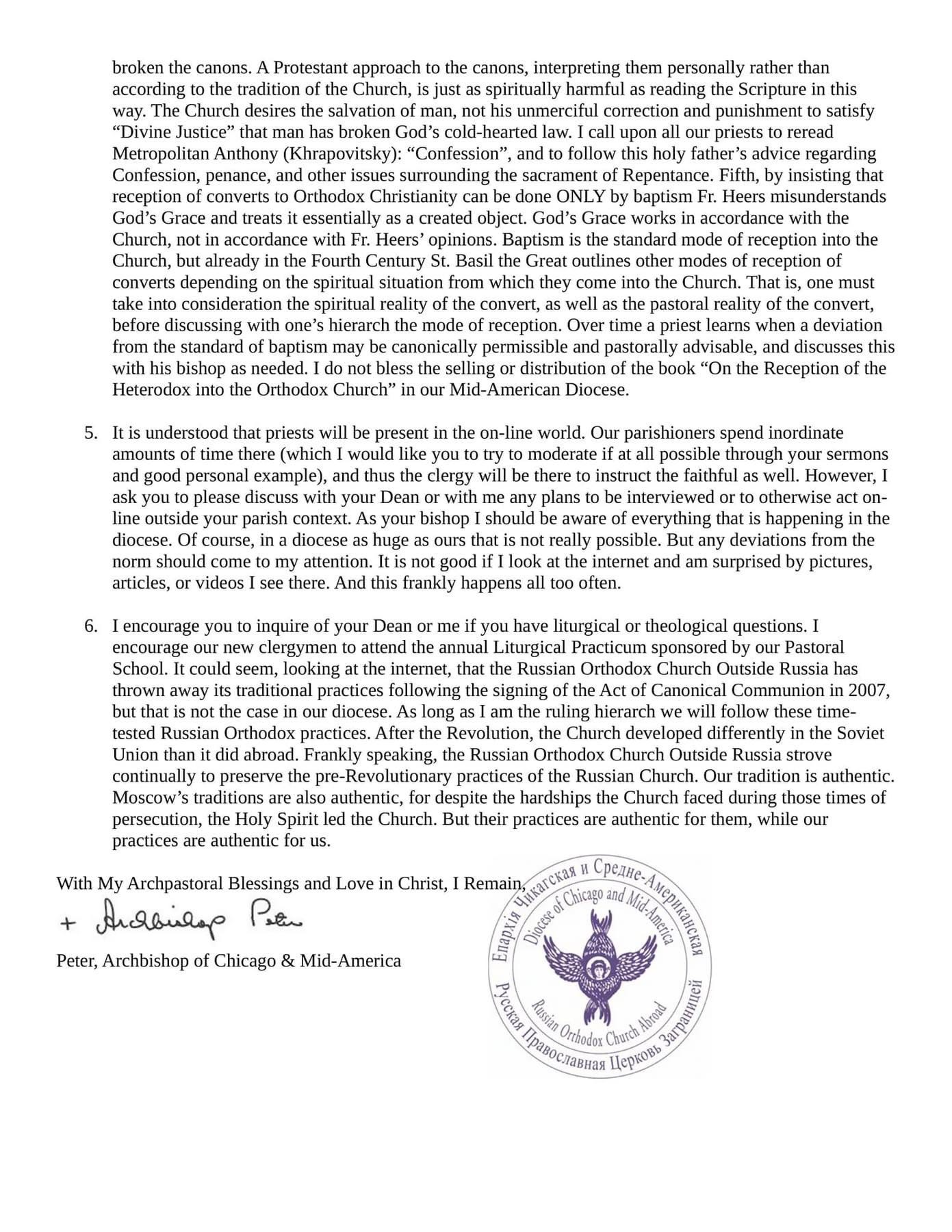This is meant to be a word of caution about Fr. Peter Heers and his endeavors. I am not here claiming that he has any malicious intent. In fact, I believe he is sincere in his efforts and is concerned about the Church at-large, which is what drives him to speak and teach as he does. However, I believe that much of what he is teaching is problematic and/or shortsighted, and is doing more harm than good.
See updates at the bottom of the page, including the Assembly of Orthodox Bishop’s April 20, 2023 statement on Heers.
Over the last several years there has been a growing movement of online, rigoristic Orthodoxy touting adherence to the “Holy Fathers” over and against the “corrupt” hierarchy of the Orthodox Church. And it may be too late to stop it.
I first noticed the strength of this movement in 2020. But its characteristic features have been around since the beginning of the Church in early “Christian” movements known for their supercilious strictness, slippery methodology, and myopic absolutism. Today, we look back on these movements and call them heresy.
Identifying the Sectarian Mindset
David Ford, Ph.D., professor of history at Saint Tikhon’s Seminary walked us through the inherent dangers of these features when I was in seminary. Drawing out key tendencies from Tertullian and the Montanist movement that form the patterns for what he calls the sectarian mindset, he lists the following:
Suspicion of the established Church: “a lack of trust that She is always being guided by the Spirit of Truth.”
Continued justification of going against the Church’s decrees: “justified/bolstered mainly by ongoing criticism and disparagement of the canonical Church.”
Unquestioned belief in one's own opinion resulting in “pridefulness and self-righteousness.”
Constant criticism: “Judgmentalism of and even contempt for those in the established Church.”
A rigorist, legalistic spirit: “excessive rigorism and a legalistic spirit concerning penitence, fasting, asceticism, the adornment of women, second marriages, fleeing in times of persecution, reception of converts, length of worship services, head coverings for women in the services, in certain moral issues.”
Harsh disposition towards those outside the Church: “A generally harsh attitude towards the non-Orthodox spurning relations with them.”
“Negative attitude towards the world and human accomplishments.”
Partisanship: “a tendency to overly identify with one particular political
and/or economic and/or social philosophy or movement.”
Apocalypse fever: “an over-emphasis on the End Times.”1
Regrettably, one can see this mindset within the walls of the Church today. For those who do not know better it can cause serious distress—especially for inquirers and those new to the faith who are often overscrupulous about getting it right. And for many, the internet is the only place they have to look, so they search for “the Orthodox view on…” Hence, it is vital that we address such websites and personalities as they have gained traction over the last few years and are greatly contributing to the confusion of the faithful.
THE NEW LEADER OF THE INTERNET CHURCH
The unofficial leader of this group is ostensibly the priest and former rector of Holy Prophet Elias church in Petrokerasa, Greece (2006–2017) Peter Heers, whose academic work and public engagement would reflect a propensity toward attributes of the sectarian mindset with greater vigor each year. In 2003 he was ordained to the Holy Priesthood by His Eminence Metropolitan Seraphim of Kastoria and served at All Saints in Kastoria, Greece (2003–2004), then the Monastery of Saint Nicholas in Kastoria (2004–2006), and finally Holy Prophet Elias (2006–2017), his last known position as rector. Heers completed his doctoral degree from Aristotle University in Thessaloniki in 2013. Two years later he published his doctoral thesis through his own publishing house (2015). The resulting book, The Ecclesiological Innovation of Vatican, would sport the tell-tale signs of one-dimensional, rigorist thinking—from painting the western Christendom as a monolith of error and the east as one of truth to his proclamation that Saint Cyprian’s view of baptism (that there is no valid baptism [or salvation] outside the [Orthodox] Church) is the indisputable consensus patrum (See Father John Cox’s assessment of these claims here). As with most of his projects, Heers would go on to imply that his conclusions are the Orthodox view.
The next phase of Heers’ career as a priest and academic would give rise to many questions, including his geographical location, canonical status, and ruling bishop. Shortly after his release from Holy Prophet Elias in Petrokerasa in Greece (reason: unknown) he began teaching full-time at ROCOR’s Jordanville Seminary in New York State (2017–2018) where he started his YouTube channel (Oct 16, 2017) titled “The Orthodox Ethos.” His full-time gig at Jordanville only lasted a year. Some claimed he was let go, others have said he left of his own volition for “greener pastures.”
In 2018 he moved his family to Florence, AZ to help start Three Hierarchs Academy where he served as headmaster for one year. His departure from the private Christian academy is as mysterious as his departure from Jordanville. And in 2019 (it is alleged) he moved his family back to Greece. All we know of Fr. Peter’s most recent endeavors is that he teaches part-time as a lecturer in dogmatics at Jordanville for their certificate program, spends time writing for his blog, running his publishing company, making video content, and producing his podcast, “The Orthodox Ethos” (announced April 1, 2020).
This is where things get even more curious. The Orthodox Church doesn’t have “free agent” priests; if one is a priest in the Church he must be attached to a bishop and diocese.2 His bishop will then approve his attachment to a specific parish. Any priest that refuses to disclose his bishop is by consequence regarded with suspicion. While Fr. Peter has publicly evaded the bishop question on several occasions, he updated his website in 2021 to include his attachment to the Jordanville Monastery as clergy under the eastern diocese of ROCOR. On August 15, 2021, the Jordanville monastery confirmed his attachment through an email exchange. We can only assume that his absence from ROCORs eastern diocese’s clergy registry (both in 2021 and to this day) was an oversight. Updating websites has never been an Orthodox strong suit.3 Most recently (November 16, 2022), Heers has updated his website and his bio again to exclude any jurisdictional attachments. It only reads, "He currently resides in the Phoenix Metropolitan Area." Although a recent tweet by a pilgrim with a photo of Fr. Theodore from Jordanville notes that, "to his knowledge" Heers is still attached to the monastery and under Bishop Luke (Update 11/17/2022, 8:15am: I was informed that Fr. Peter is not a ROCOR cleric and is not under Bishop Luke, as he has no clergy under him, and Fr. Peter was never received). Curious that the pilgrim couldn't simply ask Fr. Peter himself, who apparently now lives in Arizona.
There are several suspicious aspects here: 1. That Heers was supposedly living in Greece while attached to a ROCOR monastery in upstate New York 2. That Heers is known for frequently switching bishops. 3. That no one can trace Heers’ frequent movement or the reason for his transfer. 4. To this day, it appears that Heers has not acted as parish rector since his departure from Holy Prophet Elias in 2017. Such a record should not inspire confidence in Heers as a leader or teacher.
Yet, without the duties of an acting rector or a full-time professor, Fr. Peter found new time to pour into his online undertakings.—an enterprise that would allow him the financial freedom to spend as much time as he’d like in personal research and teaching online to the faceless masses. Within the first year (2020), he gained over 1,000 paid patrons netting somewhere between $3,000–$3,500 monthly (a conservative estimate) from Patreon.com alone.
Peter Heers and the Sectarian Mindset
Attribute 1 of the sectarian mindset is suspicion of the established Church—and criticizing bishop: a frequent topic for Heers.4 He has totally justifiable reasons (in his own mind) for his persistent criticism of the Church because, "we must follow the Saints!" (Attributes 2 and 4). If he is censured by a bishop, or synod of bishops, of an opposing view one can only surmise he would cling to his guns (Attribute 3) and "follow the Saints." In fact, he’s been laying the groundwork for such a confrontation in his ecclesiological series on YouTube, where he comments that entire synods can be wrong! This is technically true. But Fr. Peter’s understanding of what is right and what is wrong is not necessarily the Orthodox understanding. With Heers’ attitude towards those outside the Church and seeming quickness to advise others to disobey their bishops and/or hint at heresy, Attribute 5 appears self-evident. His entire doctoral work and appraisal of the 2016 Council Crete resound with Attribute 6 while Attribute 7 seems inherent in his us vs. them tendencies. His work inordinately identifies far-right ultra conservatism (Attributes 7 and 8) and he seems to be fascinated by the topic of anti-Christ and the last days (Attribute 9).5
“Who do we trust?”: Invoking Authority to Subvert Authority
“Who do we trust?” For the last two years, Heers has repeated this mantra to justify a movement away from hierarchical instructions in favor of the Saints and the “Holy men” of today. But Heers’ focus on the saints seems to be limited to a few key figures that he weaves into a broader narrative of his own making. And his “Holy men” are mainly comprised of Greek monastics on Mount Athos who adhere to fringe, radical thinking. A group that has a reputation for being reactionary.
Take Metropolitan Neophytos for example, who once commented that parents have children that are born gay when the mother engages in “unnatural acts (read: anal sex) during pregnancy.”6 Or the departed Elder Savvas Achilleos, who once warned, in the early 2000s, against the HPV vaccine, saying that girls are being told to get this vaccine but if they do they will be sterilized, a claim that has been repeatedly proven to be false.7 Elsewhere these Elders proffer theories that appear consonant with Tim Lahaye and Jerry B. Jenken's vision of the apocalypse. Greek ID cards were resisted by this group which saw its implementation as the Mark of the Beast; later, something approaching this title would be given to the COVID vaccine. Regardless of repeatedly proven false "prophecies," Heers believes we should trust these “modern elders” who speak, according to him, only what the spirit leads them. But with the belief that vaccines are intentionally poisonous in order to kill people and depopulate the Earth, or that the bird flu was manufactured for depopulation, or the HPV vaccine for sterilization, or that “unnatural acts” cause homosexuality, one cannot doubt a spirit is indeed leading them. But one wonders what kind of spirit it is.
The reality is, one can “follow the Saints” the same way that one can simply “follow the Bible:” you can pick and choose what to focus on and what to ignore and fabricate an entire theological system. But that is not how the Orthodox Church works.
The Far-Reaching Consequences
Today, neophytes across the world are turning to the internet to discover the “Orthodox Ethos.” What most are coming across is Heers’ website and YouTube channel. As eager initiates into a new faith system which offers seemingly cogent, direct answers to all your questions, they take Heers at his word—he is an Orthodox priest after all. The developing model of Orthodox faith via the operative process of the 21st century is one that takes our terminology, confessions of faith, and dogma and stretches over the frame of a Protestant ethos, the sectarian mindset. By using selective information and insisting that there are black-and-white answers to inherently gray questions—answers that are the Orthodox answers, the answers according to the faith—Heers is encouraging individuals stand up against the “faithless and perverse generation”8—or, whatever he and his coterie determines fits this criteria. Yet, only one Hierarch has spoken out against this publicly: Abp. Alexander (Golitzen).
This may be because anyone who speaks out will be the victim of Heers’ online mob and slandered by petty priests with blogs who are sympathetic to Heers’ work. Anything on the web that is combatting this hyperdox rigorism within Orthodoxy is declared as “unOrthodox” with comments such as “you are a true wolf in sheep's clothing,” “you are the spawn of satan,” “I’m unsubscribing. Thanks for showing your fangs, wolfie,” “who paid you for this propaganda” – all actual comments I have actually received.
These voices which reside within subsets of the internet are not immediately evident to Hierarchs. Forums (reddit), YouTube video comments, discord server conversations, demonstrate a growing tidal wave of restless Orthodox angst masquerading as zeal for the “true faith, the *most* ‘Orthodox’ way.” Such places reveal the pulse of what is happening in Orthodoxy today. More frightening is that this attitude is moving beyond the barriers of the internet itself. Priests are seeing this transformation within their own parish. And these individuals will often cling to what they believe is a remnant of faithful Orthodox Christians.
While it is true that synods can (and have!) made terrible decisions (Consider The Robber Council; Athanasius contra mundum; Saint Mark of Ephesus vs. Florence-Ferrara, et al.), it is not up to Heers to make this determination. But he is, publicly. And this is extremely dangerous for the Church.
What about when Bishops and Clergyman and Laity do not Agree?
When the bishops or clergymen or laity do not agree, what is the Church to do? The Church is notoriously slow moving in almost every decision—but when the swaths of faithful are being drawn into a pernicious system of belief, She acts with resounding clarity. In many cases, those who have already hardened their hearts will fall away and for whom we beg God’s mercy. But the reason the Church acts is to provide a clear way for the faithful, for the future.
We see the first instance of this in Acts 15 where “the apostles and elders came together to consider this matter [circumcision of Gentiles].”9 James, the brother of our Lord and the Bishop of Jerusalem, presided over the council. When all had been discussed they came together “in one accord” to write an authoritative letter detailing their decision on the matter. Gentiles do not need to be circumcised or keep the Jewish Law but rather refrain from “things offered to idols, blood from things strangled, and from sexual immorality.”10 The resulting decree included a formula that would be repeated in every Ecumenical Council: “it seemed good to the Holy Spirit and to us.”11 The intention of this first council was twofold: to address the erroneous claims made by certain men and to provide pastoral guidance for the troubled flock which had “unsettled in soul” by their demands.12
I have chosen to publish this article (which is a portion of a larger document I wrote in 2021) because of recent developments on Facebook, Twitter, Reddit, and other forums – and because of the recent publication of other articles by concerned Orthodox Christians on this topic. And while Heers is not the only clergyman who propounds this caricature of Orthodoxy, his online empire is growing the fastest.
Would you consider supporting my writing by becoming a member here on substack? Or by making a one-time donation via PayPal?
Read the article in which I address Heer’s claims about corrective baptisms here.
UPDATES:
*I cannot/have not confirmed update #2, partially because the entire issue is shrouded in such secrecy that to confirm, hierarchs and Heers himself (who evades such things) would have to directly respond. As such cannot say definitely, but this is what I was told.
Update 1: 11/17/2022, 8:15am: I was informed that Fr. Peter is not a ROCOR cleric and is not under Bishop Luke, as he has no clergy under him, and Fr. Peter was never received
*Update 2: from someone who read this article (11/17/2022, 12:00PM):
I can confirm (for what it's worth) that he was part of the Patriarchal Parishes in the US of Moscow Patriarchate right after he left/was let go from Jordanville. At the time I saw his name and picture on our directory. And our chancellor said that Fr Peter was received by our bishop at the time, without even the chancellor knowing. Fr Peter's name was removed from the directory just as it was added. Speaking with someone from the administration, I was told that after leaving/being let go, he left us with a sticky situation (it may have been even a law suit). I never asked for more details because, as I said, I do not care for him one way or another. He even did attend our Convocation in 2019, keeping a very low profile. I met him couple of times, he usually does not stay that quiet.
Update 3 (11/17/2022, 7:38PM): Heers posted a “Statement” to his website. This statement reveals more than it clears up.
Update 4 (11/19/2022): A reddit string was started talking about this post with some important talking points by users.
*Update 5 (11/19/2022): Peter Heers is NOT a ROCOR clergyman. It appears that Heers’ statement is deliberately misleading. The question is, why? This fact should serve as a clear caution.
Update 6 (11/21/2022): We cannot find Fr. Peter Heers listed as clergy or mentioned anywhere on the Metropolis of Piraeus’ website. We are waiting to hear back from an inquiry via email.
Update 7 (11/22/2022): We have found that Fr. Peter Heers is mentioned twice on the Metropolis of Piraeus’ website: 1
As a source in an article (January 2022) entitled, ΠΡΕΠΕΙ ΝΑ ΚΑΥΧΩΜΑΣΤΕ Ή ΝΑ ΘΡΗΝΟΥΜΕ ΓΙΑ ΤΗΝ ΕΙΣΟΔΟ ΟΡΘΟΔΟΞΩΝ ΕΚΚΛΗΣΙΩΝ ΣΤΟ Π.Σ.Ε.; Here, Fr. Peter is referenced for his “well-studied” doctoral thesis (his book, Ecclesiological Renovation of Vatican II) – footnote 10.
article (October 2022) entitled ΣΧΟΛΙΟ ΣΕ ΕΝΑ ΑΚΟΜΗ ΟΙΚΟΥΜΕΝΙΣΤΙΚΟ ΑΤΟΠΗΜΑ (Αναφορά σε πρόσφατη «βαπτισματική συμφωνία» στην Φινλανδία) Fr. Peter is cited as a source of an “excellent study” on Vatican II’s, Decree on Ecumenism (Footnote 3).
From Met. Seraphim’s very public stance on certain issues, and his use of Heers’ work here, it would seem that they have similar sentiments and proclivities. So why would Fr. Peter be so elusive about claiming him as his bishop?
Still no word from the Metropolis.
Update 8 (11/25/2022): We were sent the official release (low resolution) from Met. Seraphim of Piraeus which is dated 2018. Fr. Peter Heers is not a priest in his diocese. The release and validity of ordination documents were requested from Bishop JOHN of the Moscow Patriarchate… We have sent an email to Bishop Matthew to inquire if he is a priest in the Moscow Patriarchate (he is not listed as clergy on their website).
Please see the documents below… Attempting to get high resolution. We were told by our source that “Metropolitan Seraphim wants nothing to do with Fr. Peter.”
If he is not under the Moscow Patriarchate and is not under Metropolitan Seraphim of Piraeus… Who is Fr. Peter Heers’ bishop?
Update 9 (11/25/2022): We were sent the following article written by Craig Truglia that traces Fr. Peter Heers’ situation (without naming names). Let it be known that within any articles or statements published here, we have never alleged that Fr. Peter is “invalid” (see Craig’s statement: “many scrupulous laymen fear that somehow the priest is a free-agent, thereby invalid sacramentally”).
He writes how he came about his research:
“I was able to get into contact with Vladika Luke who is the abbot of the monastery and I expressed my sincere concerns about the situation. He agreed, as a pastoral condescension to myself, to make available all the documents connected to the situation outlined above as he was the bishop that Father Peter Heers (the “Greek priest”) was put under. I drove to Jordanville (a short ride from my home) and reviewed the documents personally.”
The Contents of the Documents. What follows is a summary of all the relevant documents. I was not blessed to make copies, but they are freely available for anyone to see if they, like me, are distraught by the whole situation and are looking for resolution. They contain letterheads and signatures, signifying they are official correspondence. Here is what they are and their contents,
A “canonical release letter” from Metropolitan Serapheim in Greece from 2018.
The letter plainly “accepts the application” regarding Father Peter Heers and issues a “canonical release” citing his good standing.
The same letter acknowledges receipt of a letter from “his Grace, John” a Russian bishop and that Father Peter Heers is to serve under him.
A “decree” from 2018 by Bishop John of the Moscow Patriarchate which commissions Father Peter Heers as a priest, with permission “to conduct missionary activity” in the United States.
A “certificate” a few months later in 2019 signed by Bishop Matthew (a different Russian bishop) to go to Australia and speak in the Serbian Diocese there, citing that Father Peter Heers is in good standing.
A letter in 2020 from Father Peter Heers to Vladika Luke (ROCOR) requesting to be transferred from the Moscow Patriarchate to ROCOR.
A letter from 2020 from Vladika Luke (ROCOR) to Bishop Matthew (Moscow Patriarchate).
The letter cites that he has “the blessing” of Metropolitan Hilarion to receive Father Peter Heers from “the jurisdiction of the Moscow Patriarchate.”
A letter from January 2021, all in Russian, from the Moscow Patriarchate.
Vladika Luke informed me that it communicates that the MP permitted ROCOR to receive Father Peter Heers provided that he be considered a Greek clergyman, due to the Patriarch (Kyril) not personally approving of the reception and thereby the MP not considering him under their jurisdiction.
An email from Metropolitan Hilarion to Vladika Luke in the same month stating that Father Peter Heers “is received into the clergy ranks of the Eastern & New York Diocese” in very large letters.
This document has no letterhead or official signature, because it is an email.
A letter from March 2021 by Vladika Luke that confirmed that Father Peter Heers “with the blessing of Metropolitan Hilarion is accepted into the ranks of clergy” for the monastery.
A letter from September 2021 signed by Metropolitan Hilarion citing theological controversy surrounding Father Peter Heers, specifically regarding vaccination (and no reference to canonical issues with his earlier release) requesting his reception be deferred until the Synod decides the question.
A letter from December 2021 on behalf of the ROCOR synod citing that despite the “good faith” of those who sought to receive Father Peter Heers that at present he is not received.
Find the article here.
But if “multiply bishops” can lay claim to him, as Craig says, then why don’t they? Why does it seem like no one wants Fr. Peter Heers?
Our concern was never about his “validity” as a priest or the sacraments he distributes. Our concern is that he has no direct oversight… and not only that, that his teaching is incorrect and dangerous. We will in time address this latter point.
Update 10: April 20, 2023: The Assembly of Canonical Orthodox Bishops issue a statement:
The Assembly of Canonical Orthodox Bishops of the United States of America is made up of all the active, canonical Orthodox Bishops in the United States of America, from every universally-recognized canonical Orthodox jurisdiction, including the Russian Orthodox Church Outside of Russia (“ROCOR”), despite the decision of its Bishops to suspend their participation in the Assembly. On November 18, 2022, the Orthodox Bishops of the Assembly received a communication from the ROCOR Eastern American Diocese regarding Archpriest Peter Heers. This communication stated “that the Very Reverend Archpriest Peter Heers is not a clergyman of the Eastern American Diocese or of the Russian Orthodox Church Outside of Russia, nor is there any pending consideration of his reception.”
The Assembly can further confirm that Archpriest Peter Heers is not a clergyman of, or on loan to, any other canonical Orthodox jurisdiction in the United States. To the extent that this individual purports to act as an Orthodox priest in the United States, including celebrating the Divine Liturgy and the other services of the Church and teaching the faithful and those who inquire into Orthodoxy, he does so in a manner outside of the Holy Canons.
Update 11:
April 21, 2023. Antiochian Archdiocese issues letter to clergy warning of Heers in reference to Assembly of Bishops Statement above.
April 21, 2023. Serbian Archdiocese posted the Assembly of Bishop’s statement on their website: https://serborth.org/news_230420_1
Update 12:
September 9, 2023: Abp. Peter of Chicago (ROCOR) issues warning about Fr. Peter Heers and his publishing companies most recent book On the Reception of the Heterodox Into the Orthodox Church
Dr David Ford, Wisdom for Today from the Early Church. Saint Tikhon’s Monastery Press: South Canaan, PA. 2014.
See Laodicea, c. 57; Holy Apostles, c.31, 39, 55; Carthage, c. 10;
See here: https://www.eadiocese.org/clergy – it is believed that, at one point, Fr. Peter was under the Moscow Patriarchete but this cannot be confirmed.
See The Council of Crete and the New Emerging Ecclesiology [OrthodoxEthos.com: March 21, 2017].
Dr. David Ford lists two more: (10) the tendency to move toward bizarre practices and (11) the sectarian group breaking up into other sectarian groups. While it is too early to tell if these two are fitting, Heers meets 9 out of the 11 criteria for the sectarian mind-set.
See Cypriot Attorney General Clears Metropolitan of Morphou in Controversial LGBT “Hate Speech” Case [OrthoChristian.com: September 10, 2019]; See the original YouTube clip of Met. Neophytos here. To be clear, I am not here advocating for such acts. But it should be abundantly clear that such a claim is nonsense.
This video of Elder Savvas (c. 2007) circulated in 2020 and some claimed that he was talking about the COVID vaccine. For HPV vaccine studies, see, Nicholas B. Schmuhl, Katherine E. Mooney, Xiao Zhang, Laura G. Cooney, James H. Conway, Noelle K. LoConte, No Association between HPV Vaccination and Infertility [www.ncbi.nlm.nih.gov: May 2020].
Matthew 17:1.
See Galatians 2:11; Acts 15:6. Saint John Chrysostom notes, in excellent exposition of this contention, laid out in his commentary on Galatians 2:11, that Peter and Paul’s confrontation was showmanship to indirectly correct the errors of others.
Acts 15:24, 29
Acts 15:28.
See Acts 15:1, 24.





